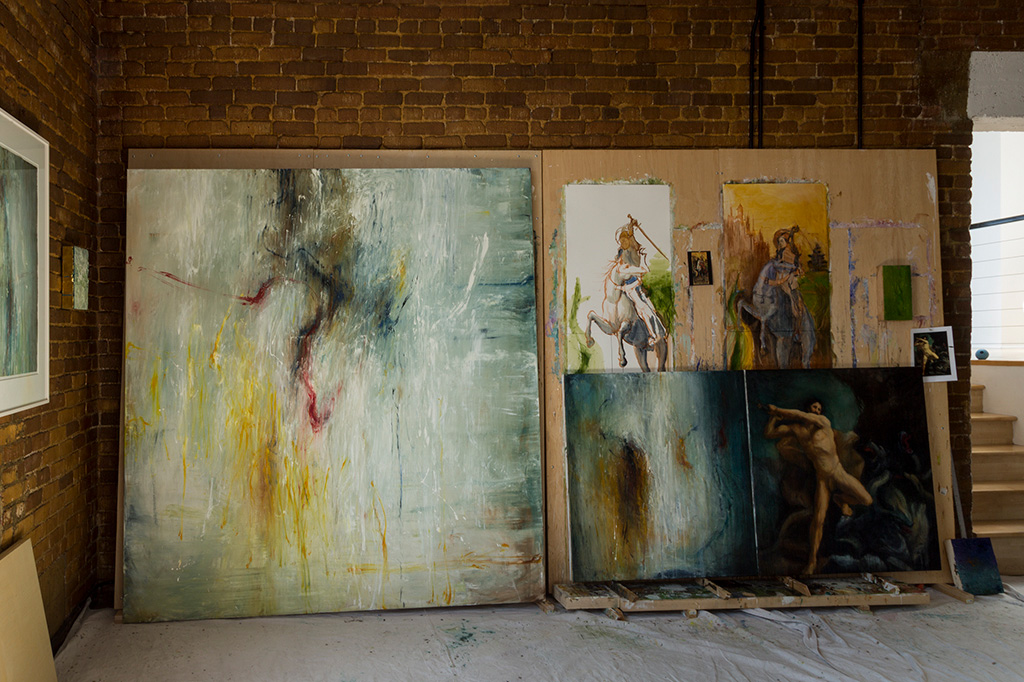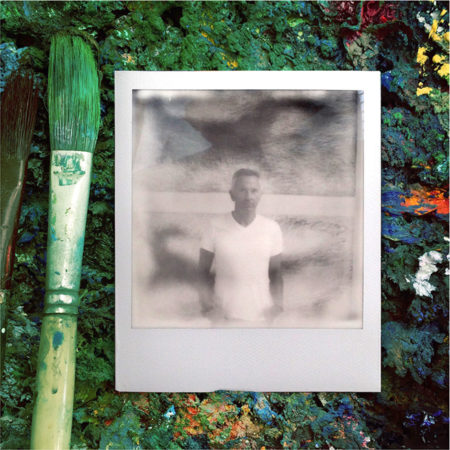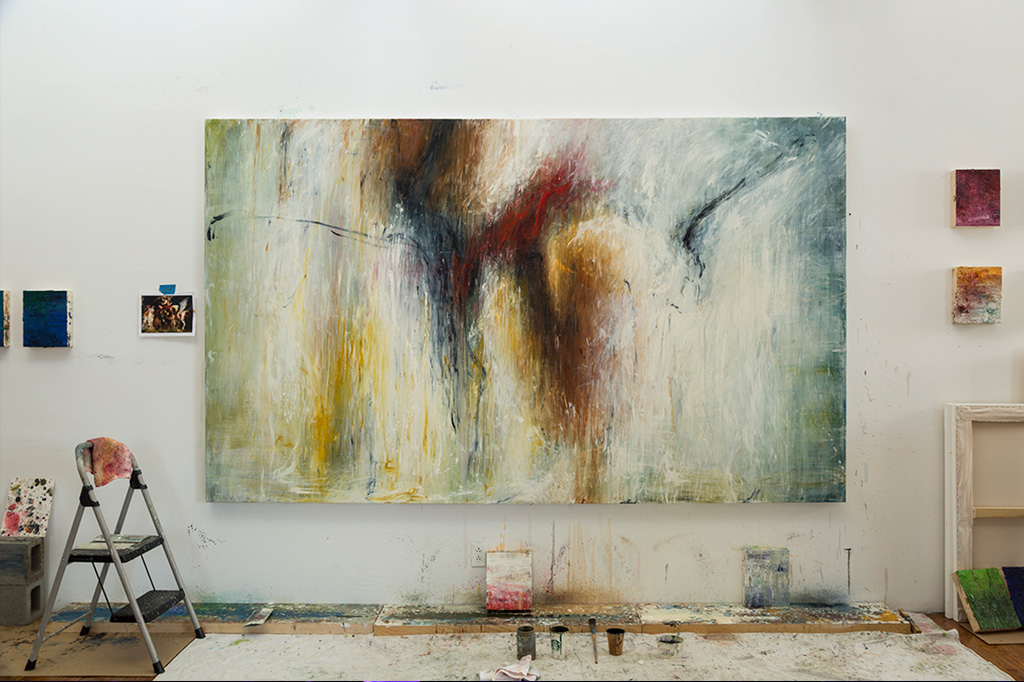In a future incarnation, and, perhaps, in response to an impending celestial influence, artist Lawrence Fodor will give a TED talk that goes something like this: “(I) would address the desperate need for the human race to reconfigure our outdated mythologies and the need to rewrite these narratives so they focus on respectful integrity, honoring life, celebrating human endeavors and achievements, accepting human beings in their infinite variety, to be encompassing and tolerant of all cultures—and not a tool for evangelism, colonialism, nor waging wars.”
But until Fodor becomes as comfortable with improvisational live dialogue as he is at translating the dialogue to canvas, the curious can engage in that theoretical construct through his current work, “ECLIPSE: obscured memories.” The revelation of the exhibit at Friesen Gallery in Ketchum gallery coincided with the Aug. 21, 2017, total eclipse that could be seen most uninhibitedly from the Valley floor.

Lawrence Fodor Studio – Los Angeles, CA, work in progress 3, July, 2017
“The covering, or eclipsing, of one celestial body by another, seemed to perfectly correlate to my conceptual concerns of appropriating significant historic works of art depicting what I felt were outdated mythologies and then covering them—‘eclipsing’ them—obliterating and recontextualizing them, in order to redefine their no-longer-relevant narratives (in terms of the health of the human race and our planet),” Fodor said.
The elaboration of that imagery began in the fall of 2014 and intensified in focus in 2015 during a 3:30 a.m. viewing of a live feed of the total solar eclipse on the Vernal Equinox. Each painting in this series is an amalgam of historical art pieces and the modern flourish of a current celestial event.
“I felt like it had been a great day in the studio as a result of this celestial event,” Fodor reasoned then, and with a few pieces and conceptual intent (not to mention 30 years of fame and familiarity for his artistic endeavors), he was promptly booked in at Friesen Gallery.
“The basic premise of ‘eclipsing’ an outdated mythology via obscuring the memory of the narrative holds fast,” Fodor explained. “In a way, I am creating my own palimpsests—within the painting medium. I am basically presenting options for new and relevant narratives to emerge and configure—via a continuing dialogue with the paintings and the viewer.
“There is an irony here, though: celestial eclipses are only momentary: their impact is profound on the human psyche and have influenced the course of political and social histories for eons—while my ‘eclipsing’ of these historic paintings is more of a permanent nature in the hope that they will have a lasting impact on the psyche of the viewer. But not for political gain, nor psychological or social control. Our outdated mythologies need redefining, rethinking and revising.
“Bottom line: I’m not painting eclipses—I’m searching for truth and beauty under the influence of celestial phenomena.”
Fodor’s work is held in numerous private collections and most recently the Modern Art Museum of Fort Worth in Texas.
His launch toward such enlightenment included an artless private parochial school, a dominant left hand, and a treehouse that served as an imagination incubator in a turbulent childhood.
“The nuns made their best attempts, unsuccessfully, to turn me into a right-hander. I diligently practiced my cursive, on the lined sheets, always with my left hand. Eventually, I learned that if I turned my paper sideways and nearly upside down, I wouldn’t drag my hand through and smear what I had just written,” he recalled, a style he still enlists. The priests, “because of their commanding abusive machismo,” made him use his right hand on the sports field and today he is an ambidextrous ball-tosser.

Collaborative portrait of the artist in his Santa Fe studio, Daniel Milnor and Lawrence Fodor, 2017
“I began to draw and paint because it was, and still is, my best, and yes, my most natural means of communicating. And, equally as important, drawing and painting was an escape from difficult childhood experiences—Catholic school being just one. I’m not convinced it was totally due to being left handed … but then again, left-handers are a tad bit prejudiced about their innate right-brain access.”
As the thrall of performing for his teachers’ exacting pursuits wore thin (he once thought becoming a Jesuit priest would align his understanding with his efforts), between the fourth and sixth grades, there was a 180-degree shift.
Fodor built himself a treehouse and cocooned away from the “pain, confusion, interference and hypocrisy of my environment,” with painting and drawing and mind travel to infinitely imagined worlds. At sixth grade, he turned away from the school and didn’t return.
“The focus shifted, and that was a good thing. My innate ability to delve inside myself was enhanced by the parochial school environment in which I was ‘trained’ or some might say, ‘indoctrinated.’ Thankfully, I was able to channel it elsewhere.”
Fodor traveled and saw, and he transcribed. He did achieve formal schooling, earning a Bachelor of Fine Arts degree through the Otis Art Institute in Los Angeles, where he returned to live part time recently after global and domestic outposts elsewhere.
“I think with my eyes,” he said. “As a result, I am always looking. Do I project into my head? Not really; the external world does that for me.”
And though the script for the “killer TED talk” Fodor dreams of is on canvas for now, the message is being delivered for those who care to look.
“There is an expansive world at large, and all we need to do is take the time to notice and to see it—be it in nature, the city, a museum, the subway … wherever. Translating that world is another matter.
“It happens intuitively once I begin to paint—but only after many, many years of training and building that visual vocabulary … And that training actually never stops.”


